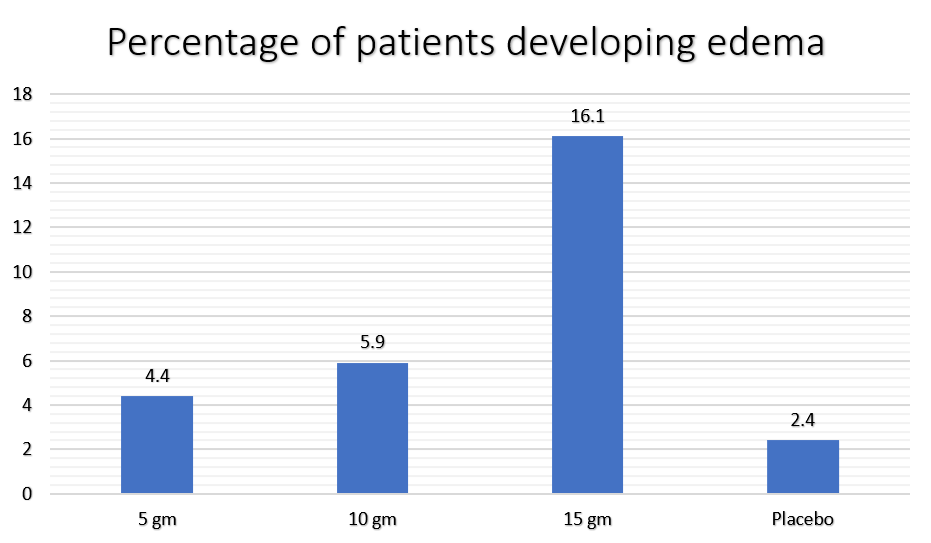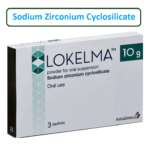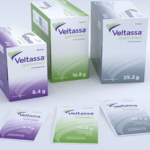Lokelma Vs Kayexalate is a comparison of the two potassium binding resins. Lokelma is the brand name of Sodium Zirconium Cyclosilicate marketed by AstraZeneca.
Kayexalate is the first and the oldest potassium-binding resin that has been in use since 1958. For the last 60 years or so, Kayexalate was the only available FDA-approved potassium-binding resin.
Even now, Kayexalate is the most commonly used potassium-binding resin because it is easily available and very cheap.
Lokelma has been recently approved by the FDA. It got its approval as a potassium-binding resin in 2018.
Although Kayexalate is widely available and very cheap compared to Lokelma and Veltassa (Patiromer), it is non-specific and associated with serious side effects.
Here, we compare Lokelma vs Kayexalate in terms of their pharmacological characteristics, safety, and efficacy.
Lokelma Vs Kayexalate: Comparison of General Pharmacological Characteristics:
Lokelma (Sodium Zirconium Cyclosilcate):
Lokelma is an inorganic insoluble, tasteless, and odorless powder that is mixed with about 45 ml of fluid and administered orally.
It binds potassium ions in exchange for sodium and hydrogen ions and prevents potassium from getting absorbed into systemic circulation.
Because it is very specific, it does not bind calcium and magnesium. Hence, it has little effect on plasma calcium and magnesium levels.
Kayexalate (Sodium Polystyrene Sulfonate):
On the other hand, Kayexalate powder is a non-specific resin that binds calcium and magnesium in addition to potassium. Thus preventing the absorption of Potassium, Calcium, and Magnesium ions.
It primarily acts in the colon and can be administered via oral as well as per rectal routes. It can also be given via a nasogastric tube (NG tube).
Lokelma Vs Kayexalate: Which Drug more rapidly removes Potassium from the body?
Lokelma has an onset of action of one hour. In clinical trials, the potassium-lowering effects of Lokelma were observed after one hour of its administration.
After 48 to 72 hours, it normalized potassium levels in about 99% of the patients.
On the other hand, the potassium-lowering effects of Kayexalate powder are very unpredictable. It may take hours to days for the potassium to drop to normal values.
Lokelma Vs Kayexalate: Summary of comparisons:
Lokelma | Kayexalate | |
| Medical Name | Sodium Zirconium Cyclosilicate | Sodium Polystyrene Sulfonate |
| Absorption | Not absorbed | Not absorbed |
| FDA Approval | In May 2018 | 1958 |
| EMA Approval | In March 2018 | Not known |
| Daily Maintenance Dose | 5 gm to 15 gm | 15 gm to 60 gm |
| Sodium Content per gm | 80 mg | 100 mg |
| Sodium Content per Day at different Doses |
|
|
| Onset of action | One hour | Hours to days |
| Specificity | Highly specific for potassium | Non-specific |
| Site of action in the Gut | Whole GI tract (Small and Larger intestine) | Binds Potassium in the Colon (Large intestine only) |
How is Lokelma Vs Kayexalate prepared and administered?
Lokelma is available as a tasteless and odorless powder. It is mixed with about 45 ml of plain water to make a suspension and is ingested immediately after preparation.
Kayexalate powder can be mixed in water or with 30 to 45 cc of lactulose and administered orally or via a nasogastric tube. It can also be administered via the per rectal route as an enema.
Lokelma Vs Kayexalate: Comparing Drug Interactions:
Both Lokelma and Kayexalate are resins and can bind other substances like medications and chemicals. Compared to Kayexalate, Lokelma has very few drug interactions.
Lokelma impairs the absorption of only those medications that require an optimal PH in the stomach or intestines to get absorbed.
Kayexalate, on the other hand, binds non-specifically to many important medications. It impairs the absorption of medications and antacids that contain cations like calcium, magnesium, and aluminum.
Kayexalate should not be given with Sorbitol as it may cause serious intestinal necrosis.
Some of the drugs that have been tested in patients who were simultaneously taking Lokelma are given in the table below [Ref]:
Absorption not affected by Lokelma | Absorption Decreased | Absorption Increased |
|
|
|
Important drugs that may not be properly absorbed while the patient is simultaneously taking Kayexalate are:
- Metoprolol
- Warfarin
- Digoxin
- Phenytoin
- Furosemide
- Amlodipine, and
- antibiotics such as amoxicillin
The manufacturer of both Kayexalate and Loklema recommends avoiding the concomitant administration of medications.
For Kayexalate, a gap of at least 3 hours is recommended between the drug and Kayexalate. For Lokelma, it is recommended to give the concomitant medication at least two hours before or two hours after Lokelma is administered.
Lokelma Vs Kayexalate: Which drug is safer?
Lokelma is a much safer alternative to Kayexalate. Lokelma does not have any known contraindications.
Kayexalate is contraindicated in patients who may be allergic to it, patients who have reduced gut motility and inflammation such as those with active inflammatory bowel disease, intestinal obstruction, and neonates with gut motility disorders.
Kayexalate has been associated with bowel ischemia, perforation, and necrosis, especially for those with underlying gastrointestinal disease or bowel ischemia, or when it is administered with sorbitol.
Lokelma has not been studied in patients with GI motility disorder and is not recommended in these patients.
The other two known side effects of Lokelma are edema and hypokalemia. Edema occurs as a result of the sodium content of Lokelma while hypokalemia is obviously the result of overtreatment.

Side effects of Kayexalate apart from intestinal necrosis are:
- Electrolyte imbalances like hypocalcemia and hypomagnesemia
- Edema and fluid overload because of the sodium content of the drug.
- Aspiration pneumonitis
- Impaired drug absorption.
Lokelma Vs Kayexalate: Which drug is more effective in correcting hyperkalemia?
Lokelma is associated with a more rapid and constant reduction in serum potassium levels. The potassium-lowering effects of Lokelma can be observed within one hour of administering the drug.
On the other hand, the potassium-lowering effect of Kayexalate is very unpredictable. It may start to lower serum potassium in hours to days.
No randomized controlled clinical trials have been conducted to assess the efficacy of Kayexalate. On the other hand, the potassium-lowering efficacy of Lokelma is well documented in multiple short and long-term clinical trials.
The potassium-lowering effect of Lokelma is dose-dependent. The higher the dose, the more likely will it lower the serum potassium.
In clinical trials, 84% and 99% of the patients achieved normal potassium levels in the plasma after 48 and 72 hours of Lokelma (given in a thrice daily dose).
The initial correction dose is administered three times a day, while the maintenance dose is given once daily [Ref].
Lokelma Vs Kayexalate: Comparing prices:
Lokelma is not available in most countries and is very costly compared to Kayexalate. Lokelma costs around USD 25 per 5 gm sachet.
The cost of Kayexalate is much less and depends on the country and pharmacy but usually, it costs less than 5 dollars (5 USD) per 5 gm of the drug.



